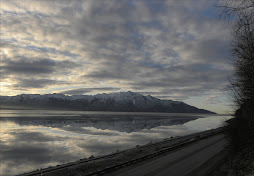

 The snow has been delayed across the river plain. Even the heights of the peaks have just a touch. However, this fact is good fortune for me, who now can roam over the huge tract a mile wide. From the bluffs 135 feet above this scene, I look out to the beginnings of the Mckinley Range, and to the smaller hills along its front. The tailings of a glacier are also there, flowing through the rock gates that open to the foothills beneath-- to the flatlands and rivers,and to the sandbars and shipwrecks of wood debris. The cold sunlight spreads over the brittle ice, into the frozen tracks of bears that now have left, and onto the gravel shores of an inland sea, where two rivers pour.
The snow has been delayed across the river plain. Even the heights of the peaks have just a touch. However, this fact is good fortune for me, who now can roam over the huge tract a mile wide. From the bluffs 135 feet above this scene, I look out to the beginnings of the Mckinley Range, and to the smaller hills along its front. The tailings of a glacier are also there, flowing through the rock gates that open to the foothills beneath-- to the flatlands and rivers,and to the sandbars and shipwrecks of wood debris. The cold sunlight spreads over the brittle ice, into the frozen tracks of bears that now have left, and onto the gravel shores of an inland sea, where two rivers pour.The climb down from the bluffs is a story of gravity. Once you step off the ridge, there is only the feeling of being drawn downwards through the shrubs and trees, and then onto the scarred slope of frozen mud and rock. Usually, the looseness of the piled material yields a foothold to the step; now however, the frozen surface is hard and my boots only skid along downwards. Unscratched, I finally reach the mud hole at the bottom. In this hollowed remains of a vanished stream, tracks are still frozen like some Ice Age catastrophe had swallowed up the beasts. But it won't be me. I circle around and head off for the river. From here, it looks like a thin blue line beneath the hill and opposite shore.
I put on another layer of clothes, covering my hands and head, insulating myself from the wind that blows from the north. Down river the dust kicks up over the open plain. I move more rapidly now. In front of me the ground is varied: with rocks, frozen mud, sand, and matted areas of dried up plants. I keep moving, stepping on the easy ground, and in twenty minutes I am there. The sound of water is more robust and alive at this divide, where two rivers become the meeting place, where rocks and trees and silt combine. In this place, water and land perform a dance, whose steps are the days which begin and end in seasonal change; where after each new flood, the captured remains are swept off until the waters recede once more.



No comments:
Post a Comment